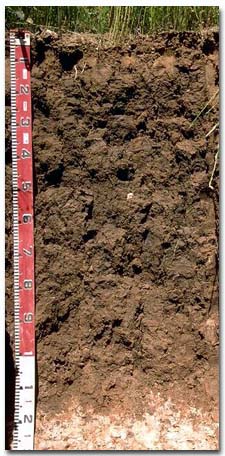LP95
Location: Gooroc
Australian Soil Classification: Petrocalcic, Epipedal, Brown VERTOSOL
Northcote Factual Key: Ug 5.3
Great Soil Group: brown clay
General Landscape Description: Upper slope of a slight rise on a gently undulating plain.
 Site LP95 Landscape |
Soil Profile Morphology:
Surface Soil
| A1 | 0-10 cm | Dark brown (7.5YR3.5/4); light medium clay; slightly self-mulching; some surface cracking evident; moderate coarse blocky structure; firm consistence dry; pH 8.3; abrupt change to: |  Site LP95 Profile |
| Subsoil | |||
| B21 | 10-70 cm | Dark brown (10YR3/3); medium heavy clay; moderate coarse prismatic, parting to strong coarse blocky structure; very firm consistence dry; contains a few (2%) angular quartz fragments (5-10 mm average size) and a few (2%) ferromanganiferrous nodules (1-2 cm size); pH 8.4; clear change to: | |
| B22 | 70-120 cm | Brown (10YR4/3) with strong brown (7.5YR5/6) diffuse mottles; medium heavy clay; moderate coarse prismatic, parting to moderate coarse blocky structure; strong consistence dry; pH 9.2; abrupt change to: | |
| C | 120+ cm | Calcrete and soft carbonate. | |
Key Profile Features:
- High clay content throughout the soil profile.
- Vertic properties (i.e. significant shrink-swell characteristic).
| - | pH | Salinity Rating | ||
Surface (A1 horizon) | moderately alkaline | low | non-sodic | none |
Subsoil (B21 horizon) | moderately alkaline | low | non-sodic | none |
Deeper subsoil (at 1 m) | very strongly alkaline | low-medium | sodic | strong |

Management Considerations:
Whole Profile
- Plant available water capacity (PAWC) is considered to be medium (estimated at 110 mm). This is based on available laboratory data and assumes an effective rooting depth of 70 cm. Rooting depth will be restricted by the sodic and very strongly alkaline subsoil.
- The surface soil is non-sodic and has a very high level of exchangeable calcium. It is slightly self-mulching and will provide a good rooting environment for plants.
- The surface soil has a very high inherent fertility (based on the sum of the exchangeable basic cations).
- The upper subsoil is non-sodic and has a very high level of exchangeable calcium. Root and water movement is not likely to be significantly restricted in the upper subsoil as a result.
- The deeper subsoil becomes sodic and dispersive and is likely to restrict root and water movement at depth.
- The deeper subsoil (from 30 cm depth) becomes strongly alkaline. This indicates that some nutrients (e.g. iron, manganese, copper, zinc) may be poorly available to plants at depth.
- Soluble salts increase in the deeper subsoil but only reach low-medium levels by 70 cm depth. Plant growth is unlikely to be restricted at these levels.
- Linola grown at time of sampling, then a wheat crop planted.
- 300 kg/hectare gypsum applied last year.
- Very weedy paddock.


